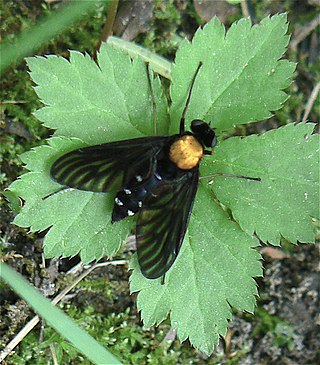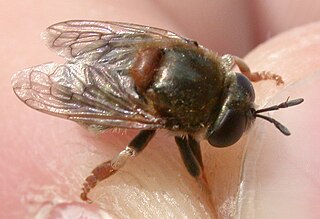
Chrysopilus is common, worldwide genus of predatory snipe flies. There are approximately 300 species in the genus, including fossil members that are sometimes found in amber.

Rhagionidae or snipe flies are a small family of flies. They get their name from the similarity of their often prominent proboscis that looks like the beak of a snipe.

Hover flies of the genus Microdon are unusual among the Diptera. Like other members of the subfamily, they are myrmecophiles, meaning they inhabit the nests of ants.

Rhagio is a worldwide genus of predatory snipe flies. Several species in this genus are referred to as downlooker or down-looker flies because they sometimes perch on tree trunks in a head-down position. There are approximately 170 species. They can be distinguished from other rhagionids by the open anal cell on the wings and the lack of a kidney-shaped arista.
Spaniopsis is a genus of snipe flies of the family Rhagionidae. They are very stout bodied flies from 3 to 6 mm, with generally grey or dark grey thorax, and are only known from Australia.
Austroleptis is a genus of snipe flies, and the sole genus in the family Austroleptidae; until 2010, it was placed in the family Rhagionidae. They are small to moderately sized flies of around 3 to 7.7 mm.

Bolbomyia is a genus of snipe flies, and the sole genus in the family Bolbomyiidae; until 2010, it was placed in the family Rhagionidae. They are a small 2 to 3.5 mm, brown or black in color, with lightly infuscate (darkened) wings. They are restricted to the north temperate region of North America and Russian Far East (Kamchatka).
Arthroteles is a genus of snipe fly of the family Rhagionidae. Species of Arthroteles are moderately sized, from 5 to 7.5 mm. They are gray to dark gray in colour. Their antenna bears seven to eight tapering flagellomeres, the first much larger than all others.
Atherimorpha is a genus of snipe fly of the family Rhagionidae.
Desmomyia is a genus of snipe flies of the family Rhagionidae. They have the antennal scape elongated, longer than the pedicel, and the male hind first tarsomere enlarged. Desmomyia are mid-sized flies of about 5 to 7 mm and of grey, black, or brownish colour and the legs have some yellow or dark brown to black.
Schizella is a genus of snipe flies of the family Rhagionidae. They are delicate flies from 3.7 to 6.3 mm, with long, thin legs, and the thorax is brown to orange-brown with blue, purple, or golden-coloured setae.

Hybos is a genus of hybotid flies.

Pachygastrinae is a subfamily of flies in the family Stratiomyidae.

Rachicerus is a genus of flies in the family Xylophagidae.

Atherix is a genus of 'ibis flies' belonging to the family Athericidae, a small family very similar to the Rhagionidae. Species within this genus are present in most of Europe and also in the Nearctic realm.

Chrysopilus cristatus, is a species of 'snipe flies' belonging to the family Rhagionidae.

Chrysopilus erythrophthalmus is a Palearctic species of snipe fly in the family Rhagionidae.

Chrysopilus laetus is a Palearctic species of snipe fly in the family Rhagionidae.

Drapetis is a genus of flies in the family Hybotidae.

Spaniinae is a worldwide subfamily of predatory snipe flies.














